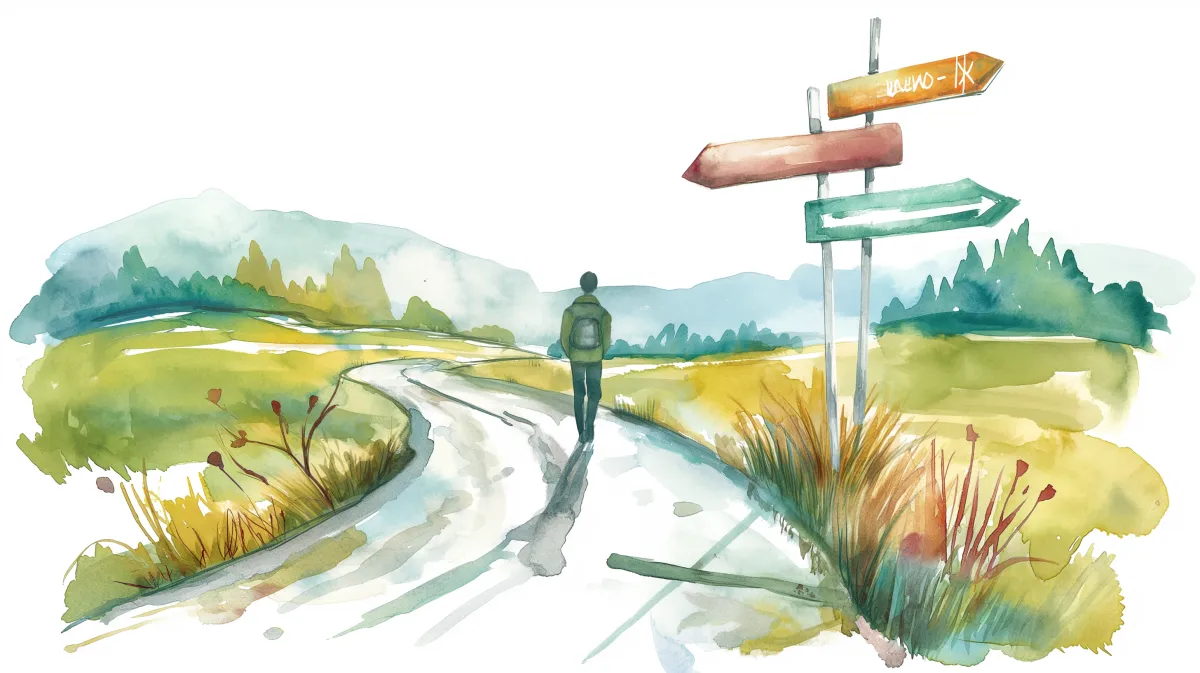Life Guide
How to Draw and Follow Your Unique Path in Life
• public
Table of contents
Life is an exciting journey and it is unique for every one of us. Here, I talk about this journey and how we can draw our own paths.
I suggest taking a look at the purpose of the guide, the table of contents, and its story. This way, you'll easily see value of it.
But if you're eager to dive right in, you can get this 13,800+ word guide below.
The Purpose of This Guide
The main purpose of this guide is to introduce you to a powerful tool: questions.
Questions can be signposts on your life journey. If you can ask them at the right time and with the right perspective, they can lead you to the right path.
They can clear your mind and eliminate chaos from your life. They support you in walking your path with clarity and confidence.
I'll delve into various ways of using questions to achieve them, from daily life activities to finding your life purpose and beyond.
All of this is to create a better life for all of us.
I also suggest checking "Life Hub" to better comprehend the purpose of this guide, as Life Hub and Life Guide are closely linked.
Who is This Guide For?
- If you don't know how to shape your life,
- If you seek clarity and confidence in what you do,
- If you wish to deep dive into issues and make the right decisions,
- If you aim to eliminate incorrect or unnecessary ideas and beliefs,
Then, this guide is for you.
In fact, it is for everyone, regardless of your past, personality, age, background, or culture.
What Will You Get?
By the end of this guide, you will gain the following:
- Powerful questions on various topics.
- A unique perspective on how to use questions in your life.
- Question-based guides on fundamental aspects of your life.
- Links to an actionable structure to implement everything in Life Guide (Life Hub).
- Extra resources (books, movies, talks) to support your life journey.
You can also check content of this guide in detail below;
Table of Contents of Life Guide
Introduction
- The Purpose of This Guide
- Who is This Guide For?
- What Will You Get?
- How to Use This Guide?
- How to Apply This Guide?
- Story of This Guide and Me
The Journey
The Questions
- Work (Meaning, Purpose)
- Health (Physical, Mental)
- Relationships
Finding The Right Questions
How to Use Questions
- Macro Level
- Micro Level
Fundamentals
- Health
- Passive Income
- Movement
Concepts
Sources
- Books
- Movies
- Talks
Your Thoughts
How to Use This Guide?
I recommend you use this guide in the following order:
- Read the introduction sections right away. They will give you perspective on this guide.
- Try to answer the example questions in the "The Questions" section. You will experience the effects of powerful questions.
- Check the fundamentals and concepts sections and deep dive into topics of interest. You will get detailed guidance on these fundamentals and concepts.
- Use Life Hub to implement everything in this guide and more into your life. You will have a structured, actionable plan for your life.
- Check the sources section to support your journey. You will find valuable content on personal development.
You can subscribe below and get this guide for free;
How to Apply This Guide?
You can apply everything in this guide and much more via following hub. If you want detailed information, click on it.

Story of This Guide and Me
I've always found it hard to fit into traditional systems like education, business, and community rules. They didn't guide me well.
I didn't feel comfortable or happy in these structures, often finding them boring.
So, I had to forge my own path.
I didn't know where to begin. For some time, I looked for practical solutions. I tried to see the bigger picture, exposing myself to different situations to understand myself and my desires.
I read and thought a lot. But it wasn't enough. It felt disorganized and inefficient.
I was searching for a guiding principle to base my life on. I was looking for a meta skill to lead me forward.
One day, I came across a powerful question that changed my perspective. It was something I had been overlooking. I realized the skill I was seeking was the ability to question everything.
However, I didn't immediately see its potential impact on my life. I wasn't sure how to actively incorporate it.
Then, I learned how to use questions to shape my path. They became a fundamental part of my daily routine. I started to question:
- What's important to me,
- What I want in life,
- How I feel in different situations,
- Why I do what I do (habits, routines, daily activities),
- And more.
This skill gave me clarity in life. It helped me find my way.
That's why I want to share this knowledge, this perspective with you. This is one of the most important meta-skills you can learn in your life. You can apply it to everything in your life.
Even though we are all unique, it can help every one of us.
It doesn't matter that we all have different pasts, personalities, goals.
It doesn't matter that we're changing throughout our lives.
Questions can always guide you through your life.
Get It For Free
You can subscribe below and get this guide for free;
Your Thoughts
Want me to make a new section on a certain topic or expand an existing section? Or did you notice a bug, wrong information on the website? Drop me a line at info@gorkemgumustekin.com. I love hearing your thoughts and suggestions.
Support My Work
Did you find my content helpful or enjoyable? You can click below to leave a tip if you'd like to support my work! Your generosity is greatly appreciated and helps me continue creating valuable content for you and others. Thank you for considering!
Buy me a coffee
